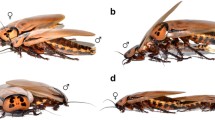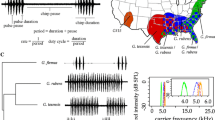Summary
The widespread occurrence of wing polymorphisms in insects suggests that the possession of wings and ability to fly adversely affect components of the insect's life characteristics that contribute to its Darwinian fitness. This hypothesis was tested by an analysis of the differences in life history parameters of the macropterous and micropterous morphs of the two cricket species G. firmus and A. fasciatus. In both species there were no differences in development time or adult survival between the two morphs. Significant differences in head width were not consistent between the two species but in both sexes of G. firmus and females of A. fasciatus (insufficient males for analysis) long-winged individuals weighed more than short-winged individuals with the same head width. In both species egg production is delayed in macropterous females. The cumulative fecundity of the micropterous morph is greater than the macropterous morph in both species but only in G. firmus is the difference statistically significant. A. fasciatus frequently loose their wings but no such loss has been observed in G. firmus. There is a significant increase in egg production after the loss of the wings. These results are in accord with those of Tanaka (1976) for the cricket, Pteronemobius taprobanensis.
Breeding experiments indicate that in G. firmus the wing polymorphism is under genetic control. The decrease in fecundity is sufficiently large that genotypes producing only macropterous offspring could only persist in highly unstable environments where continuous dispersal was imperative for survival. However, the reproductive cost of a genotype producing a small percentage of macropterous individuals is slight. The fitness that accrues to a genotype producing a few dispersing offspring is likely to offset the small reproductive cost and hence wing polymorphisms should be favoured.
Similar content being viewed by others
References
Alexander RD (1968) Life cycle origins, speciation and related phenomena in crickets. Quar Rev of Biol 43:1–41 (1968)
Alexander RD, Thomas ES (1959) Systematic and behavioral studies on the crickets of the Nemobius fasciatus group (Orthoptera: Gryllidae: Nemobiinae). Ann Ent Soc America 52:591–605
Anderson N (1973) Seasonal polymorphism and developmental changes in organs of flight and reproduction in biovoltine pondskaters (Hem. Terridae). Ent Scandia 4:1–20
Anderson M, Finlayson LH (1973) Ultrastructural changes during growth of the flight muscles in the adult tsetse fly, Glossina austeni. Insect Physiol 19:1989–1997
Balboni ER (1967) The respiratory metabolism of insect flight muscle during adult maturation. Insect Physiol 13:1849–1856
Byers GW (1969) Evolution of wing reduction in crane flies (Diptera: Tipulidae). Evolution 23:346–354
Davis NT (1975) Hormonal control of flight muscle histolysis in Dysdercus fulvoniger. Ann Ent Soc America 68:710–714
De Kort CAD (1969) Hormones and the structural biochemical properties of the flight muscles in the Colorado beetle. Meded. Land., Wageningen, 69:1–63
Dingle H, Arora G (1973) Experimental studies of migration in bugs of the genus Dysdercus. Oecologia (Berlin) 12:119–140
Dixon AFG (1972) Fecundity of brachypterous and macropterous alatae in Drepanosipham dixoni (Callaphididae, Aphididae). Entomol Exp Appl 15:335–340
Dixon AFG, Wratten SD (1971) Laboratory studies on aggregation, size and fecundity in the black bean aphid, Aphis fabae Scop. Bull Ent Res 61:97–111
Harrison RG (1980) Dispersal polymorphisms in insects. Ann Rev Ecol Syst 11:95–118
Johnson CG (1969) “Migration and dispersal of insects by flight”. Methuen, London
Kisimoto R (1965) Studies on the polymorphism and its role-playing in the population growth of the brown planthopper Nilaparvata lugens Stal Bull Shikoha agric exp station 13:1–106
May YY (1971) The bilogy and population ecology of Stenocranus minutus (Fabricius) (Delphacidae, Homoptera). Ph.D. thesis, Univ. of London
Mochida O (1973) The characters of the two wing-forms of Javesella pelucida (F.) (Homoptera: Delphacidae) with special reference to reproduction. Trans Roy Ent Soc London, 125:177–225
Myers JH (1976) Distribution and dispersal in populations capable of resource depletion. A simulation model. Oecologia (Berlin) 23:255–269
Myers JH, Campbell BJ (1976) Distribution and dispersal in populations capable of resourse depletion. Oecologia (Berlin) 24:7–20
Ready NE, Josephson RK (1982) Flight muscle development in a hemimetabolous insect. J Exp Zool 220:49–56
Roff DA (1975) Population stability and the evolution of dispersal in a heterogeneous environment. Oecologia (Berlin) 19:217–237
Roff DA (1978) Size and survival in a stochastic environment. Oecologia (Berlin) 36:163–172
Sokal RR, Rohlf FJ (1981) Biometry (2nd ed.). W.H. Freeman and Company, p 859
Tanaka S (1976) Wing polymorphism, egg production and adult longevity in Pteronemobius taprobanenis Walker (Orthoptera: Gryllidae). Kontyu, 44:327–333
Veazey JN, Kay CAR, Walker TJ, Whitcomb WH (1976) Seasonal abundance sex ratio, and macroptery of field crickets in northern Florida. Ann Ent Soc America 69:374–380
Vepsäläinen K (1974) Determination of wing length and diapause in water striders (Gerris fabr., Heteroptera). Hereditas 77:163–175
Vepsäläinen K (1978) Wing dimorphism and diapause in Gerris: determination and adaptive significance. In: Evolution of insect migration and diapause Dingle H (ed) Berlin-Heidelberg-New York: Springer
Vickery VR, Johnstone DE (1973) The Nemobiinae (Orthoptera: Gryllidae) of Canada. Can Ent 105:623–645
Waloff N (1973) Dispersal by flight of leafhoppers (Auchenorrhyncha: Humoptera). J Appl Ecol 10:705–730
Williams CM, Barnes LA, Sawyer WH (1943) The utilization of glycogen by flies during flight and some aspects of the physiological ageing of Drosophila. Biol Bull Wood's Hole 84:263–272
Wratten SD (1977) Reproductive strategy of winged and wingless morphs of the aphids Sitobion avenae and Metopalophium dirhodum. Ann appl Biol 85:319–331
Young EC (1965) Flight polymorphism in British corixidae: ecological observations. J Anim Ecol 34:353–389
Author information
Authors and Affiliations
Rights and permissions
About this article
Cite this article
Roff, D.A. The cost of being able to fly: a study of wing polymorphism in two species of crickets. Oecologia 63, 30–37 (1984). https://doi.org/10.1007/BF00379781
Received:
Issue Date:
DOI: https://doi.org/10.1007/BF00379781




